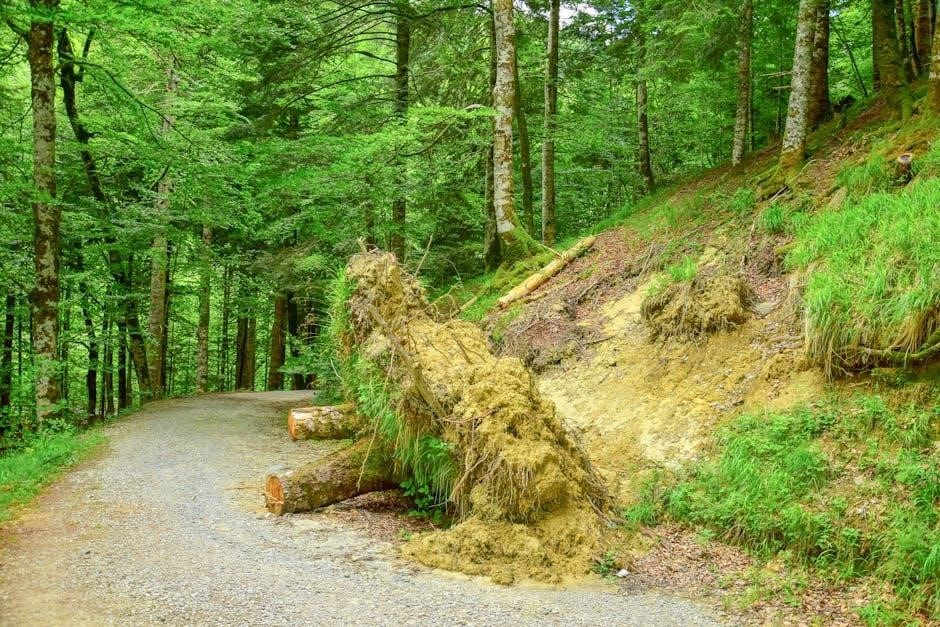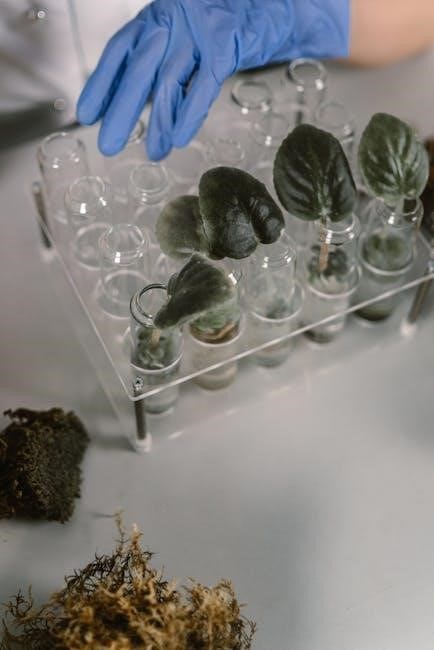Ecological succession explores how ecosystems change over time, with species colonizing and transforming habitats. This process is vital for understanding ecosystem recovery and biodiversity development.
1.1 Definition and Overview
Ecological succession is the gradual and predictable process of ecosystem change, where plant and animal communities replace one another over time. It occurs in both natural and disturbed environments, leading to the development of a climax community. This process is driven by factors such as soil quality, climate, and species interactions. Understanding succession helps us appreciate how ecosystems recover and evolve, providing insights into biodiversity and environmental resilience. It is a fundamental concept in ecology, essential for managing and restoring ecosystems effectively.
1.2 Importance of Studying Ecological Succession
Studying ecological succession is crucial for understanding ecosystem recovery, biodiversity, and long-term environmental changes. It provides insights into how species adapt and interact over time, shaping habitat dynamics. Succession helps predict ecosystem responses to disturbances like fires or human activities. This knowledge is vital for conservation, restoration, and managing natural resources effectively. By analyzing succession patterns, scientists can develop strategies to promote ecosystem resilience and sustainability, ensuring healthy environments for future generations. It also aids in understanding the impact of human interventions on natural processes.
1.3 Lab Objectives and Learning Outcomes
This lab aims to help students understand ecological succession by observing changes in an abandoned hay field over time. Objectives include counting tree species, analyzing succession stages, and interpreting data to draw conclusions. Students will learn to identify key species, graph data, and formulate hypotheses about ecosystem changes. By the end of the lab, participants will be able to explain succession processes, predict future ecosystem states, and apply concepts to real-world environmental scenarios, enhancing their critical thinking and analytical skills in ecology;

Ecological Succession Lab Setup

The lab setup involves materials like tree charts, soil samples, and data sheets. Safety includes proper clothing and eyewear. Variables such as time points and species are key.
2.1 Materials and Equipment Needed
The lab requires materials like tree identification charts, data sheets, and graph paper for recording observations. Equipment includes measuring tapes, soil samplers, and magnifying glasses. Safety gear such as gloves and closed-toe shoes is essential. Additional resources include access to the ecological succession lab answer key PDF for reference and analysis. Ensure all tools are sterilized and properly calibrated before use to maintain accuracy and safety throughout the experiment.
2.2 Lab Safety Guidelines
Wear appropriate clothing, including long pants and closed-toe shoes, for outdoor work. Use gloves when handling soil or plants, and eyewear for sun protection. Ensure purposeful behavior in the field to avoid accidents. Sterilize tools before use to prevent contamination. Follow proper protocols when handling biological materials. Supervision is recommended for all activities. Be prepared for varying weather conditions and ensure access to first aid kits. Familiarize yourself with emergency procedures and maintain a clean workspace throughout the experiment.
2.3 Experimental Design and Variables
The lab involves observing an abandoned hay field over time, tracking tree species growth at 5, 20, 50, and 100 years post-abandonment. Independent variables include time and environmental conditions, while dependent variables are tree species count and diversity. Data collection involves counting and identifying tree species using a provided key. Graphing techniques will illustrate changes, aiding in hypothesis testing and understanding succession dynamics. This design allows students to analyze ecological changes and interpret results effectively.

Understanding Succession Stages
Succession stages describe the predictable changes in ecosystems over time. Primary succession begins with lifeless areas, while secondary succession occurs in disturbed but biologically rich environments.
3.1 Primary and Secondary Succession
Primary succession occurs in areas with no prior biological presence, such as after volcanic eruptions or glacier retreats. It begins with pioneer species like mosses and lichens, gradually developing into complex ecosystems. Secondary succession happens in disturbed areas with existing soil, like abandoned fields or burned forests. It progresses faster, starting with weeds and shrubs, then transitioning to trees. Both processes illustrate how ecosystems recover and evolve over time, shaped by environmental conditions and species interactions.
3.2 Timeline of Succession in the Abandoned Hay Field
The abandoned hay field undergoes distinct succession stages over time. At 5 years, pioneer species like weeds and grasses dominate. By 20 years, shrubs and small trees emerge, increasing biodiversity. At 50 years, larger trees like pine and oak become prevalent, forming a canopy. By 100 years, a mature forest develops, with a mix of hardwoods and a dense understory. This timeline highlights how species composition evolves, reflecting changing environmental conditions and competition dynamics, essential for understanding ecological succession patterns.
3.3 Key Species and Their Roles
Key species play crucial roles in shaping the abandoned hay field’s succession. Pioneer species like weeds and grasses stabilize soil and prepare the area for larger vegetation. Shrubs and small trees, such as birch and cherry, follow, providing shade and altering light conditions. Larger trees like pine and oak dominate later stages, forming a canopy and creating a layered forest structure. Each species contributes to habitat diversity, nutrient cycling, and ecosystem resilience, illustrating how species interactions drive ecological succession and ecosystem maturation over time.

Data Collection and Analysis
Data collection involves counting tree species over time, while analysis uses graphing techniques to visualize trends and comparisons, aiding in interpreting ecological succession patterns and ecosystem changes.
4.1 Counting Tree Species Over Time
Counting tree species over time involves observing and recording the number of each species present at different stages of succession. In the abandoned hay field lab, students count tree species at 5, 20, 50, and 100 years post-abandonment. This method helps track changes in biodiversity and ecosystem composition. The ecological succession lab answer key PDF provides detailed guidance on accurate counting techniques, ensuring reliable data collection. By comparing results over time, students can analyze patterns, such as species dominance shifts and ecosystem stabilization, which are critical for understanding ecological succession dynamics and interpreting lab findings effectively. This process supports hypothesis testing and data-driven conclusions.
4.2 Graphing Techniques for Succession Data
Graphing techniques are essential for visualizing ecological succession data. Common methods include line graphs to show changes in species abundance over time and bar graphs to compare biodiversity at different stages. Students plot tree species counts from the abandoned hay field at 5, 20, 50, and 100 years post-abandonment. The ecological succession lab answer key PDF provides examples of these graphs, ensuring clarity and accuracy. By analyzing these visual representations, students can identify patterns, such as species dominance shifts and ecosystem stabilization, which are key to understanding succession dynamics and interpreting lab results effectively.
4.3 Interpreting Results and Drawing Conclusions
Interpreting succession data involves analyzing trends in species composition and abundance over time. Students compare observed patterns with initial hypotheses to assess ecosystem recovery. Key observations include shifts in species diversity, dominance, and the pace of succession. The ecological succession lab answer key PDF provides guidelines for accurate interpretation, highlighting common mistakes. By relating findings to broader ecological principles, students draw conclusions about the resilience of ecosystems and the factors influencing succession. This step reinforces the practical application of succession concepts in understanding environmental changes and ecosystem management.

Answer Key and Worksheet Solutions
This section provides the correct answers and detailed explanations for lab questions and activities, ensuring students can verify their work and understand key ecological succession concepts effectively.
5.1 Correct Answers for Lab Questions
The answer key provides precise solutions to all lab questions, including species identification, timeline analysis, and graphical interpretations. It ensures accuracy in understanding ecological succession stages and processes, offering clear explanations for each query to enhance comprehension of ecosystem dynamics and biodiversity changes over time.
5.2 Explanations for Common Mistakes
Students often miscount tree species or misinterpret succession timelines. The key highlights these errors, explaining how incorrect species identification and miscalculations can skew results. It also addresses common misconceptions about primary vs. secondary succession, offering insights to avoid such mistakes and improve data accuracy in future analyses, ensuring a clearer understanding of ecological processes and their implications for ecosystem development and stability.
5.3 Sample Worksheets and Solutions
The sample worksheets provide structured exercises for analyzing ecological succession data, such as counting tree species over time and interpreting graphs. They include questions about succession stages, species roles, and ecosystem changes. The solutions offer detailed answers, ensuring clarity and accuracy. These resources help students assess their understanding and identify areas for improvement. Worksheets also include charts for data entry and analysis, guiding learners through the process of drawing conclusions about ecological changes over time, making them an invaluable tool for both students and educators.

Advanced Concepts in Ecological Succession
Advanced concepts delve into human impacts, disturbances, and hypothesis testing, exploring how these factors influence ecosystem recovery and biodiversity over time.
6.1 Impact of Human Activities on Succession
Human activities significantly influence ecological succession by altering habitats and disrupting natural processes. Deforestation, urbanization, and pollution accelerate species invasion and reduce biodiversity, modifying recovery timelines. Agricultural practices, such as fertilization, can enhance nutrient availability, speeding up succession stages. Climate change extends growing seasons, favoring certain species over others, leading to shifts in community composition. Understanding these impacts is crucial for managing ecosystems and predicting long-term environmental changes, as highlighted in ecological succession lab resources.
6.2 Role of Disturbances in Shaping Ecosystems
Disturbances, such as fires, hurricanes, or human interventions, play a crucial role in shaping ecosystems by resetting succession. These events remove dominant species, alter environmental conditions, and create opportunities for new species to colonize. Natural disturbances often trigger primary succession, while human-induced ones may lead to secondary succession. Disturbances influence biodiversity, nutrient cycling, and habitat structure, making them key drivers of ecosystem change. Understanding their impact is essential for predicting succession patterns and managing ecosystems effectively, as explored in ecological succession lab materials.
6.3 Hypothesis Testing in Succession Studies
Hypothesis testing is a critical component of ecological succession research, allowing scientists to validate theories about ecosystem changes. By formulating hypotheses, such as how nutrient addition affects succession, researchers can design experiments to test these ideas. Data collection, including species counts and environmental measurements, is analyzed to determine if results align with predictions. This iterative process refines understanding of succession dynamics, helping to identify patterns and causal relationships. Hypothesis testing ensures rigorous scientific inquiry, guiding future experiments and ecological management strategies, as detailed in ecological succession lab materials.

Lab Report and Presentation Guidelines
Lab reports should include clear objectives, methods, results, and conclusions. Presentations should summarize key findings visually, using graphs and charts to enhance understanding. Peer reviews ensure accuracy and clarity, providing constructive feedback for improvement. Adherence to these guidelines ensures professional and effective communication of ecological succession concepts and experimental outcomes, fostering deeper understanding and collaboration among participants.
7.1 Structuring the Lab Report
Your lab report should begin with a clear title and introduction, outlining the objectives and scope of the ecological succession study. The materials and methods section should detail the experimental setup, including the abandoned hay field scenario and tree counting methodology. Results should be presented with graphs and charts showing species population changes over time. The discussion section should interpret these findings, linking them to ecological principles. Conclude with a summary of key insights and their implications. Ensure clarity and logical flow, using the answer key as a reference for accurate data interpretation and presentation. Proper formatting and adherence to scientific writing standards are essential for a professional report.
7.2 Tips for Effective Presentations
When presenting your ecological succession lab findings, ensure your presentation is well-organized and visually engaging. Begin with a clear introduction, outlining the lab’s objectives and key concepts. Use graphs and images to illustrate changes in tree species over time, referencing the answer key for accuracy. Practice your delivery to maintain a smooth flow and engage your audience with questions or interactive elements. Highlight key insights, such as the impact of time on biodiversity, and conclude with a summary of your findings. Encourage feedback to refine your presentation skills and deepen understanding of succession principles.
7.3 Peer Review and Feedback Mechanisms
Peer review is a crucial step in refining your ecological succession lab report. Exchange your work with classmates and use the answer key as a guide to assess accuracy. Provide constructive feedback on data interpretation, graph analysis, and hypothesis testing. Highlight strengths and areas for improvement, ensuring comments are specific and actionable. This collaborative process fosters a deeper understanding of succession concepts and enhances scientific communication skills. Regular feedback loops help refine your work, aligning it with lab objectives and improving overall quality.

Additional Resources and References
Access the full PDF answer key, supplementary materials, and recommended reading for deeper understanding of ecological succession concepts and lab experiments.
8.1 Recommended Reading and Websites
For deeper understanding, explore textbooks like Ecology: The Economy of Nature and online resources such as Course Hero and Quizlet. The Ecological Succession Lab Answer Key PDF is available on platforms like Scribd and Google Scholar. Websites like Khan Academy and Biology Corner offer interactive content and practice questions. Supplementary materials, including lab manuals and study guides, provide comprehensive insights into succession experiments and data analysis techniques. These resources support both theoretical learning and practical application of ecological succession concepts.
8.2 Accessing the Full PDF Answer Key
To access the full Ecological Succession Lab Answer Key PDF, visit platforms like Course Hero or Scribd, where comprehensive guides are available. Some resources require registration or subscription for full access. The PDF includes detailed answers, explanations, and insights into ecological succession experiments. It covers data analysis, hypothesis testing, and common mistakes, making it a valuable tool for students and educators. Ensure to download from reputable sources to avoid incomplete or incorrect materials. The PDF is designed to enhance understanding and support lab report preparation effectively.
8.3 Supplementary Materials for Deeper Understanding
Supplementary materials for ecological succession include interactive simulations, video tutorials, and case studies. These resources provide hands-on learning opportunities, such as virtual labs and quizzes, to reinforce key concepts. Additionally, recommended reading lists and educational websites offer in-depth insights into succession processes. Supplementary materials also cover advanced topics like human impact on succession and disturbance ecology, aiding students in developing a comprehensive understanding of ecological principles and their real-world applications. These tools are ideal for students seeking to explore beyond the lab manual and enhance their critical thinking skills.

Frequently Asked Questions
How do I interpret the stages of ecological succession over time? Use the provided answer key and observe changes in species diversity and ecosystem structure for clarity.
9.1 Common Queries About the Lab
Students often ask about interpreting succession stages, graphing techniques, and understanding species roles. The answer key PDF provides detailed explanations for lab questions and activities. Common queries include how to count tree species accurately, how to analyze data over time, and how to differentiate between primary and secondary succession. Additionally, students seek clarification on hypotheses related to nutrient impacts and disturbance effects. The lab guide offers step-by-step solutions and visual aids to address these concerns, ensuring a comprehensive understanding of ecological succession.
9.2 Clarifications on Key Concepts
Key concepts often require clarification, such as distinguishing between primary and secondary succession. Primary succession occurs in lifeless areas, while secondary succession happens in areas with existing soil and vegetation. Students also seek clarity on succession stages, species colonization, and the role of disturbances. The answer key PDF explains these concepts in detail, addressing common misunderstandings about species replacement and ecosystem recovery. It also clarifies how to interpret timelines and biodiversity trends, ensuring a clear understanding of ecological processes.
9.3 Troubleshooting Experimental Issues
Common issues in ecological succession labs include inaccurate tree counts, species misidentification, and delayed succession. To address these, ensure precise counting methods and use identification guides. Slow succession may result from environmental factors like poor soil quality or lack of sunlight. Consult the answer key PDF for detailed solutions and verify experimental conditions to align with expected outcomes. Regularly monitoring changes and maintaining consistent data collection protocols can help mitigate discrepancies and ensure accurate results.
10.1 Summary of Lab Findings
The lab demonstrated ecological succession’s progression in an abandoned hay field over 100 years. Data revealed a shift from pioneer species like grasses and shrubs to a diverse forest ecosystem. Tree species composition changed significantly, with early species declining as later species dominated. Graphs illustrated increasing species diversity and population fluctuations. Disturbances and human activities were identified as key factors influencing succession. The findings highlighted the dynamic nature of ecosystems and the importance of long-term observation in understanding recovery patterns and biodiversity development.
10.2 Applications of Succession Knowledge
Understanding ecological succession is crucial for environmental management, conservation, and restoration. It aids in predicting ecosystem recovery after disturbances, guiding reforestation efforts, and restoring degraded habitats. Succession knowledge informs strategies for maintaining biodiversity, managing wildlife reserves, and mitigating climate change impacts. It also supports sustainable agriculture and urban planning, ensuring land use aligns with natural ecosystem processes. By applying succession principles, scientists can develop effective conservation plans and predict long-term ecosystem changes, fostering resilience in both natural and human-altered environments.
10.3 Suggested Areas for Further Research
Future research could explore the impact of climate change on succession timelines and species composition. Investigating how human activities, such as deforestation or pollution, alter succession pathways is another critical area. Long-term studies on rare or endangered species’ roles in succession could provide insights into biodiversity conservation. Additionally, examining the interaction between disturbances and succession in different ecosystems, like coral reefs or arctic tundras, would broaden our understanding; Finally, integrating remote sensing and advanced data analysis techniques could enhance the study of succession patterns on a global scale.
